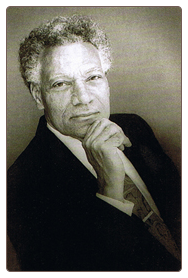Ivan Van Sertima: Difference between revisions
No edit summary |
No edit summary |
||
| Line 1: | Line 1: | ||
[[File:Ivanvansertima.png|thumb|Ivan Van Sertima<ref>Dr. Ivan Van Sertima, The Journal of African Civilizations, Inc., 2017, http://www.journalofafricancivilizations.com/VanSertima.</ref>]] | [[File:Ivanvansertima.png|thumb|Ivan Van Sertima<ref>Dr. Ivan Van Sertima, The Journal of African Civilizations, Inc., 2017, http://www.journalofafricancivilizations.com/VanSertima.</ref>]] | ||
Ivan Van Sertima was a Guyanese historiam, and | Ivan Van Sertima was a Guyanese historiam, linguist, and a associate professor of Africana Studies at Rutgers University in the United States. He was best known for his Olmec alternative origin speculations, a brand of pre-Columbian contact theory. <ref>Peoplepill. “About Ivan Van Sertima: British Africanist in New Jersey (1935 - 2009): Biography, Facts, Career, Wiki, Life.” Peoplepill, 2021, https://peoplepill.com/people/ivan-van-sertima. </ref> | ||
== Early Life == | == Early Life == | ||
Revision as of 00:57, 15 December 2021

Ivan Van Sertima was a Guyanese historiam, linguist, and a associate professor of Africana Studies at Rutgers University in the United States. He was best known for his Olmec alternative origin speculations, a brand of pre-Columbian contact theory. [2]
Early Life
Ivan Van Sertima was born in Kitty Village, near Georgetown, Guyana. In 1964, Van Sertima married Maria Nagy and together they adopted two boys. He then attended the School of Oriental and African Studies (SOAS) at the University of London, graduating in 1969 as an honor student with a Bachelor of Arts degree in African languages and literature. In 1970, Van Sertima began his graduate work at Rutgers University in New Brunswick, New Jersey. After his divorce from Maria, he married Jacqueline Pattern in 1984 and gained two stepdaughters.
Theories & Afrocentrism
He was best known for his Olmec alternative origin speculations, a brand of pre-Columbian contact theory, which he proposed in his book They Came Before Columbus (1976). While his Olmec theory has "spread widely in African American community, both lay and scholarly", it was mostly ignored in Mesoamerican scholarship, and has been dismissed as Afrocentric pseudoarchaeology and pseudohistory to the effect of "robbing native American cultures." In this book, Ivan Van Sertima explores his theory that Africans made landfall and had significant influence on the native peoples of Mesoamerica, primarily the Olmec civilization. Van Sertima accomplishes this through chapters relying heavily on dramatic storytelling. This technique, as well as the ambiguity of the evidence Van Sertima used, have led to the rejection of his work as pseudoscience or pseudoarchaeology. This work was published by Random House and did not go through a peer review process. Van Sertima reached larger audiences through chapters narrated by figures of the past, including Christopher Columbus and the Mali king Abu Bakr II. In doing this, primary source anecdotes are often the evidence cited by Van Sertima combined with inference and exaggeration, though he implies to his readers that the narrative is based in fact. In Chapter 5, called "Among the Quetzalcoatls", Van Sertima narrates the arrival of Abu Bakr II to an Aztec civilization in Mexico in 1311, describing the Mali king as "a true child of the sun burned dark by its rays" in direct and explicit comparison to the Aztec "sun god" Quetzalcoatl, as Van Sertima writes. This interaction is not rooted in historical evidence and Van Sertima does not offer a cited source to back up his narrative. This is one of many examples of Van Sertima's theories that Mesoamerican mythologies are based on Pre-Columbian African contact theories. Between narrative chapters, Van Sertima develops his main claims about African contact with the Americas in an essay style and includes images of artifacts, which primarily consist of photographs of ceramic heads that Van Sertima says have African features. Van Sertima also includes photos of an African man and woman for comparison, but he does not include pictures of inhabitants of the area where the artifacts were found. Van Sertima focuses specifically on the Olmec colossal heads, saying that the characteristics of the stone faces are "indisputably" African, while Mesoamerican experts such as Richard Diehl disregards this claim, as the statues are stylized and generally accepted as representing native Mesoamericans. [3]
Publications
They Came Before Columbus: The African Presence in Ancient America (1976)
Criticism
Legacy
References
- ↑ Dr. Ivan Van Sertima, The Journal of African Civilizations, Inc., 2017, http://www.journalofafricancivilizations.com/VanSertima.
- ↑ Peoplepill. “About Ivan Van Sertima: British Africanist in New Jersey (1935 - 2009): Biography, Facts, Career, Wiki, Life.” Peoplepill, 2021, https://peoplepill.com/people/ivan-van-sertima.
- ↑ Haslip‐Viera, Gabriel, et al. “Robbing Native American Cultures: Van Sertima’s Afrocentricity and the Olmecs.” Current Anthropology, vol. 38, no. 3, [The University of Chicago Press, Wenner-Gren Foundation for Anthropological Research], 1997, pp. 419–41, https://doi.org/10.1086/204626.